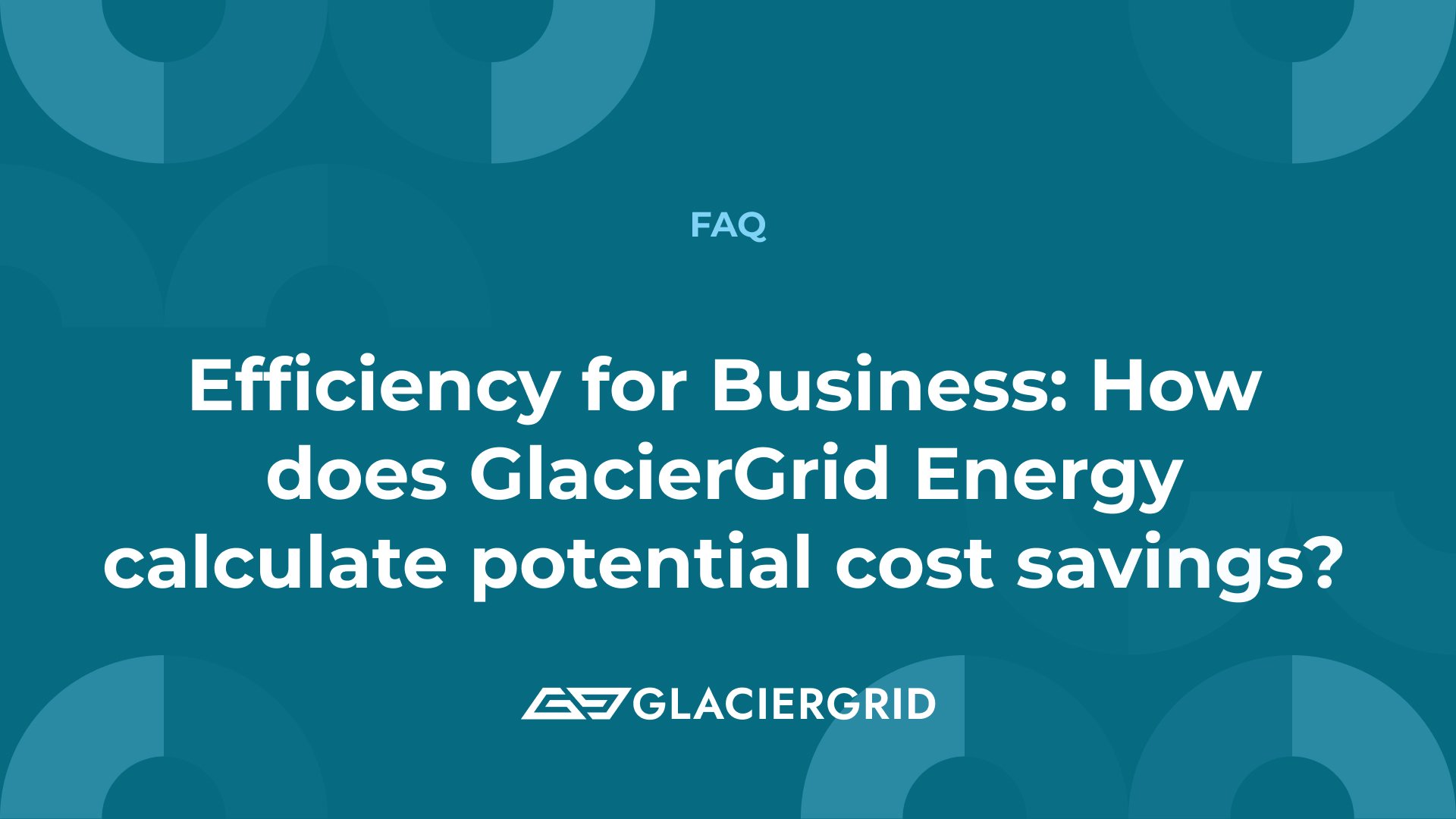Efficiency for Business: How does GlacierGrid Energy calculate potential cost savings?

Energy efficiency is no doubt becoming increasingly important in today's business landscape.
As such, our commitment to empowering businesses with the knowledge and tools needed to optimize their energy usage and reduce costs effectively is also a top priority.
This guide provides a clear and comprehensive understanding of how GlacierGrid calculates potential business cost savings through our energy efficiency solutions. It answers frequently asked questions regarding our calculation methods, mainly focusing on the International Performance Measurement and Verification Protocol (IPMVP) Option C and incorporating various data in our analysis.
How does GlacierGrid Energy calculate potential cost savings for businesses?
GlacierGrid Energy calculates potential cost savings using the International Performance Measurement and Verification Protocol (IPMVP) Option C. IPMVP was developed by the Efficiency Valuation Organization (EVO) and the US Department of Energy as a framework designed to measure and verify energy performance and savings from energy-efficiency projects.
This method comprehensively analyzes 12 months of past energy data, diverse weather conditions, and billing cycle lengths. We use regression analysis to understand and project energy savings, factoring in various weather-related influences and operational data.
What is the significance of using IPMVP in energy management?
Using IPMVP in energy management offers several benefits:
Accurate measurement:
It provides precise measurement and verification of energy savings, making it a reliable and trustworthy basis for claims related to energy efficiency.
Credibility and trust:
Since IPMVP is an internationally recognized standard, businesses that adhere to this boost the credibility of energy conservation initiatives.
Informed decision-making:
Accurate data from IPMVP enables better decision-making and benchmarking across facilities.
Continuous improvement:
It allows for ongoing monitoring and optimization, leading to the identification and implementation of further energy-saving measures.
What is IPMVP Option C, and why does GlacierGrid Energy use it?
The IPMVP offers several options for verifying savings—each suited to different types of projects and available data. These options are categorized as A, B, C, and D, each providing a different methodology for measurement and verification (M&V).
IPMVP options explained
Option A: Partially measured retrofit isolation
This option measures energy savings through key component measurement and uses estimates for the rest of the system. It's typically used when direct energy savings measurements are possible for significant project components but only for part of the system.
Option B: Retrofit isolation
Option B measures energy savings by isolating and directly measuring the energy use of systems or subsystems. It suits projects with localized energy savings to specific equipment or systems, allowing for direct and precise measurement.
Option C: Whole facility
Option C assesses energy savings at the whole facility level by comparing total energy use before and after implementing energy efficiency measures. This approach is valuable for projects with multiple energy conservation measures affecting various systems, making it difficult to isolate individual savings. It relies on utility bills or whole-building metering to assess changes in energy consumption.
Option D: Calibrated simulation
This option estimates energy savings using computer simulations calibrated with actual facility energy use data. It's often used when physical measurements are impractical or the project involves complex interactions between various building systems.

Deepen Your Knowledge of IPMVP and Its Impact on Energy Efficiency.
Why does GlacierGrid Energy use IPMVP Option C?
GlacierGrid Energy opts for IPMVP Option C for several reasons:
- Comprehensive data capture: Option C enables the assessment of energy consumption and savings across the entire facility. This accommodates the diverse and wide range of GlacierGrid Energy's solutions. This approach also ensures that all changes in energy consumption attributable to multiple energy efficiency measures can be accurately captured.
- Flexibility and scalability: Given GlacierGrid Energy's focus on optimizing energy usage, Option C's whole-facility perspective allows for scalable applications across different sizes and types of buildings.
- Transparency and credibility: Option C facilitates transparent and credible reporting of energy savings by comparing total energy use before and after the implementation of energy efficiency measures. This transparency is crucial for stakeholders—business owners, building owners, investors, and even regulatory bodies, ensuring confidence in the reported outcomes.
- Simplified measurement: Though Option C provides comprehensive insights into energy savings, it eliminates the need for detailed measurements of individual systems or components, streamlining the measuring and verification (M&V process). This simplification benefits large-scale projects where isolating specific savings from individual measures would be too complex and resource-intensive.
In a nutshell, IPMVP Option C aligns with GlacierGrid Energy's objectives by providing a robust, credible, and scalable methodology for measuring and verifying the energy savings achieved through their comprehensive energy efficiency solutions. This choice underscores GlacierGrid Energy's commitment to delivering transparent and reliable energy savings to its clients.
What kind of data is used in the IPMVP Option C calculation?
The calculation uses a variety of data, including:
- Energy consumption data from meters or utility bills.
- Weather data include heating and cooling degree days, temperature variations, humidity levels, solar radiation, wind speed, and other relevant climatic factors.
- Operational data, such as occupancy rates and production shifts, which can influence energy consumption.
Are adjustments made in the energy savings calculation process?
Yes, GlacierGrid Energy makes routine and non-routine adjustments during calculation. These adjustments consider operational changes, such as variations in occupancy or production shifts, and changes in weather patterns that might influence energy usage.
How does GlacierGrid Energy ensure the accuracy of its energy savings calculations?
GlacierGrid Energy ensures accuracy through continuous measurement and verification of energy use and pre- and post-implementation of energy efficiency measures. Using IPMVP Option C and rigorous data analysis and adjustments, GlacierGrid provides reliable and verifiable energy savings reports for our clients.
We hope this guide has clarified our approach to calculating energy savings and the importance of comprehensive data analysis.
Our goal at GlacierGrid Energy is to offer energy efficiency solutions and educate and empower businesses in their journey towards sustainable and cost-effective energy management. Should you have any further questions or require personalized assistance, please do not hesitate to contact our support team or visit the GlacierGrid Energy website for more information.
Additional Resources
For further information and deeper insights into energy management and savings, we encourage you to explore the following resources:
- The Power of IPMVP: Unlocking the True Potential of Energy Savings
- What is Energy Management?
- A Restaurant Owner's Roadmap to Energy Optimization
- SAJJ Mediterranean Case Study
- Energy Savings Calculator
These resources offer valuable insights and practical guidance on implementing energy-efficient practices in various business settings.








.jpg)